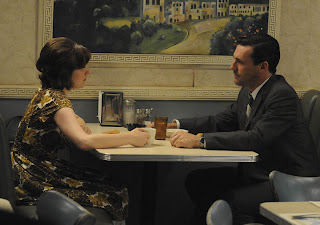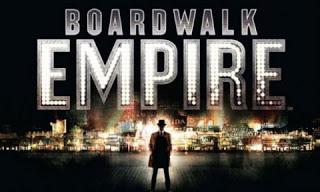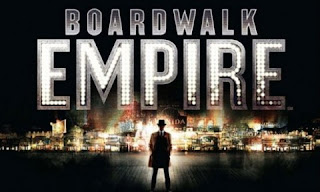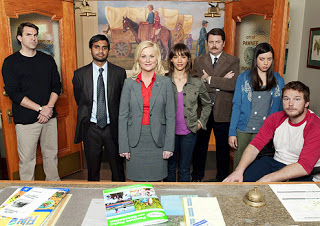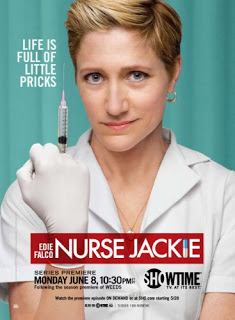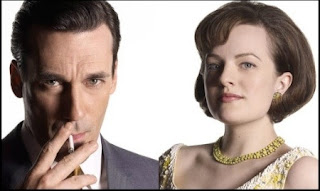 |
| Don Draper and Peggy Olson |
Category: On Television
Mad Men Week: Is Mad Men the Most Feminist Show on TV?
Written by Megan Kearns, cross-posted from The Opinioness of the World.
Historians are notorious for savaging historical fiction. We’re quick to complain that writers project modern values onto their characters, get the surroundings wrong, cover up the seamy side of an era or exaggerate its evils — and usually, we’re right. But AMC’s hit show “Mad Men”…is a stunning exception. Every historian I know loves the show; it is, quite simply, one of the most historically accurate television series ever produced. And despite the rampant chauvinism of virtually all its male characters (and some of its female ones), it is also one of the most sympathetic to women…But in 1965, feminism wasn’t a cultural option for most women. It would be another year before the National Organization for Women, the group that gave so many women the legal tools to fight discrimination, would be founded. Newspapers still ran separate want ads with separate pay scales for female jobs, seeking “poised, attractive” secretaries and “peppy gal Fridays.”
“But I have to say, most of the things negroes can’t do, I can’t do either. And nobody seems to care…Half of the meetings take place over golf, tennis, and a bunch of clubs where I’m not allowed to be a member or even enter.”
“What do you do around here besides walking around like you’re trying to get raped?”
there wasn’t even a word for the sexual harassment the character Joan experiences.
Joan’s decision to not go through with her abortion this season stirred up controversy. In an article at RH Reality Check, Sarah Seltzer argues,
“Mad Men” is known for being excruciatingly period-specific. Joan was not at a modern-day abortion clinic and she was not privy to a modern-day abortion debate. She had followed a specific plan which involved breaking the law and risking arrest–which speaks to a strong determination to begin with. There were no protesters and no one to tell her what she did was immoral. Sure, by the standards of her time she was a “loose woman” but there was no pro-life movement calling women selfish babykillers…It’s realistic for her character, the time period, and the plot for Joan to have had the abortion. The show’s writers and the many viewers who think “she didn’t go through with it” are imagining a modern-day conception of abortion fueled by iffy anti-choice tropes found in movies like “Juno” or shows like “The Secret Life of the American Teenager.
The real reason so many fictional characters choose to keep their babies may be much simpler than any of these theories: Babies advance plotlines, whereas abortions end them. As Ted Miller, a spokesperson for NARAL Pro-Choice America, said, “The history of abortion storylines has been mixed. The very personal circumstances are often lost in the pursuit of dramatic or sensationalized storylines.” An abortion can carry a single episode, or a few scenes in a film, while a baby provides fodder for seasons’ worth of material…Sure, Weiner could have found other ways to teach us more about the characters he’s created. But Joan’s decision on Mad Men—and Miranda’s on Sex and the City, and Juno’s in Juno, and so on—show that on screen, advancing the plot is more important than making a political statement.
Obviously Joan is not anti-abortion as she’s had two previous procedures. Barkhorn points out that some say screenwriters don’t want to show abortions as “they don’t want their heroines to appear unsympathetic.” While 1 in 3 women in the U.S. will have an abortion in her lifetime, it’s so rare for a film or TV show to depict that choice. Only a handful of shows have portrayed a character having an abortion including Maude, Private Practice and Friday Night Lights. Barkhorn also points to characters on Sex and the City (Samantha and Carrie) both of whom had abortions in their characters’ past. But when Miranda becomes pregnant and resigned to have an abortion, she backs out at the last moment. While some characters have gone through with abortions, it makes it seem that it’s a decision that young people choose, not successful adult women.
“You do your job so well. They respect you and you don’t have to play any games. I didn’t know that was possible.”
Peggy: “You know I just saved this company. I signed the first new business since Lucky Strike left. But it’s not as important as getting married…again.”
Joan: “Well I was just made Director of Agency Operations, a title, no money of course. And if they poured champagne it must have been while I was pushing a mail cart.”
Peggy: “A pretty face comes along and everything goes out the window.”
Joan: “Well I learned a long time ago to not get all my satisfaction from this job.”
Peggy: “That’s bullshit.”
Then they giggle knowingly.
We should be glad that the writers are resisting the temptation to transform their female characters into contemporary heroines. They’re not, and they cannot be. That is the brilliance of the show’s script. “Mad Men’s” writers are not sexist. The time period was.
Things They Haven’t Seen: Women and Class in Mad Men
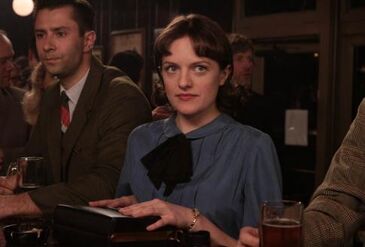 |
| Peggy Olson |
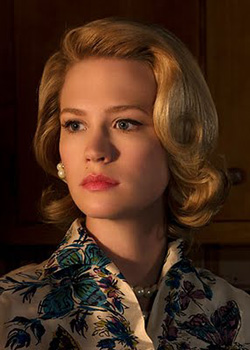 |
| Betty Draper Francis |
 |
| Joan Holloway Harris |
Mad Men YouTube Break: The Mad Men School of Seduction
Sexual harassment or seduction? Sometimes it’s a fine line in Mad Men.
In my opinion, the best line award goes to Peggy:
I’m in the persuasion business, and frankly I’m disappointed by your presentation.
Or maybe it goes to Roger, for sheer…weirdness:
I want to suck your blood like Dracula.
What are some of your favorite “lines” from the show?
‘Mad Men’ Week: Hey, Brian McGreevy: Vampire Pam Beats Don Draper Any Day
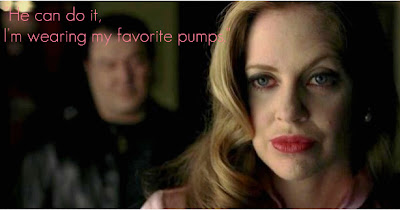 |
| Vampire Pam saying, “He can do it; I’m wearing my favorite pumps.” |
Just as the Frito-Lay Company has created virtually nutrient-free vehicles of corn syrup and salt that make our youth fat, slow, and indiscriminate, the Castrati vampire is a confection that has the same impact on the psycho-dramatic imagination of today’s youth. Think of the message here: What is the consequence of falling in with a Romantic vampire? Death, either yours or his. What is the consequence of falling in with the Castrati vampire? Long and torturous (at least to everyone around you) conversations about feelings. This is not what really happens when you fall in with attractive monsters.McGreevy isn’t feeling Stephanie Meyer’s sparkling undead abstaining teens. But he has equal disdain for the sexed up vamps on True Blood, which, in his words, is “like Tennessee Williams fucked The Rocky Horror Picture Show.” See, blood suckers should be real men “ideal men” like Mad Men’s Don Draper.
Of course I refer to Don Draper on the AMC series Mad Men, the purist’s vampire of choice for our time. This one has teeth. And adding an extra layer to the mystique is his position as an advertising executive. A more elegant embodiment of the metaphor could hardly be asked for: He is an engine of want, creating the illusion of fulfillment while sucking you dry. No is not in his vocabulary. Neither is yes—yes is implicit. He knows this, he is past needing to hear you say it. He knows the private and unmentionable place that cries “yes” when the bottom drops out of an amusement park ride and suddenly you are in free fall, and, like the ideal man, he is listening.
When Mad Men first premiered, much of its appeal was attributed to novelty factor: What a different time it was, when the American male was an unrecognizable breed of scandalous, id-driven malefactor; heedless, rapacious, just waiting to slide off his doe-eyed secretary’s pencil skirt and show off his executive account.
…
Men are predators at heart. Any refutation of this is also a refutation of evolution, or the common sense conclusion of observing a typical 3-year-old boy at unstructured play, his wake of destruction the envy of a Visigoth. It is a killer’s heart that is the motive force of masculinity and predation its spirit. This is not to suggest nature is immutable, or that one ought to act in blind obeisance to it, but that “ought” is not in the vocabulary of want, and choosing is meant to have consequences.
Guest Writer Wednesday: Boardwalk Empire
Ripley’s Pick: Parks and Recreation Seasons 1 & 2
A small-town political satire, shot in the same documentary style as The Office, the show is laugh-out-loud funny, smart, and cuttingly feminist (and we know how rare it is for network TV to even pass the Bechdel Test). To compare it to The Office doesn’t really do it justice, however, as The Office really depends on its one-bit-gag of inept office manager Michael Scott (Steve Carrell) and other caricatures working together.
Parks and Recreation centers around Leslie Knope (Amy Poehler), who is smart and capable, yet who sometimes suffers from grandiose delusions and tragically funny missteps in her position of Deputy Director of the Parks and Recreation Department in Pawnee, Indiana. With her friend Ann Perkins (Rashida Jones), boss Ron Swanson (Nick Offerman), intern April Ludgate (Aubrey Plaza), and rest of the crew, Leslie sets out to build a new park in the small town and climb the political ladder.
Leslie Knope is openly feminist and politically ambitious. Her office is decorated with framed photos of female politicos, including Madeleine Albright, Condoleeza Rice, Hillary Clinton, and Janet Reno–along with her mother, who holds a higher political office than she. She struggles to accomplish anything in her bureaucratic position, fit in with the boys’ club of government, and navigate the social world of her small town. The supporting cast is equally good, with nearly all characters fully formed and three-dimensional. One of several great performances is Offerman’s anti-government Ron Swanson, the head of the Parks & Rec department, whose primary goal in his position seems to be the complete privatization and elimination of the department. Equally funny is April the intern, an ironically detached hipster who gradually grows annoyed with her gay boyfriend and comes around to sincerely connecting with her coworkers.
Season One was a short six episodes, while Season Two had twenty-four. At the end of the second season, the government was facing a shutdown due to budget concerns. Season Three (again, premiering next week) begins with the re-opening of the Parks and Recreation department. Here’s a sneak peak at Season Three, featuring guest stars Rob Lowe and Ben Scott. The preview relies heavily on these and other guest stars, and I hope they don’t dominate the series this season, superseding Poehler’s excellent comedic performance.
And here’s a clip from one of my favorite episodes, “Hunting Trip.”
Guest Post: Nurse Jackie as Feminist Id?
Guest Post: Tara is Better Not United
This guest post also appears at Professor, What If… and the Ms. Magazine blog.
Alas, to my dismay, the show’s bubbly focus on a recovered Tara Gregson (Toni Collette) meant that the “alters”–alternate personalities of this 21st century Sybil–were gone, thrown out like the unwanted clothing ceremoniously dumped into a charity bin in the show opener. Instead, we have happy, functioning Tara, and an upbeat musical soundtrack trying to manipulate us to believe that, indeed, all is well in the Tara-verse.
But we soon learn that Tara as one person, no longer suffering from dissociative identity disorder, is not nearly as fun or interesting as she is as five different people. Instead, the “true Tara” now displays some of the most annoying traits of all five of her alters.
She incorporates her Alice-esque alter by donning a 50s-style apron and throwing herself into a dinner party with the neighborhood’s token gay couple. She speaks her mind Buck-style (Buck was a beer-swigging male alter) when a neighbor commits suicide, bragging “The lady with all the personalities is not the most fucked up person on the block.” After the dinner party, her T-proclivities (that was the teenaged alter) come out, and she performs a manic Bollywood number, ending with provocative thrusting in her hubby’s face. Her sister Charmaine assures her new beau that Tara has not actually “transitioned” into the other personality, indicating that perhaps it would be better if she did, while Tara’s husband Max is visibly worried that the new “sane” Tara might be more insane than before.
Given the show’s emphasis on the self as performative, and on the impossibility of performing to societal standards (especially if one is female), this suggestion that Tara’s recovery may not be a step forward is intriguing. Though the show reveals all the difficulties Tara’s disorder causes for her and her family, it also seems to be indicating that the real problem is a society that expects us to perform in very particular, stable and normative ways. These regulatory ideals are so oppressive that we either bind ourselves into limited roles (i.e., Alice-the-50s-housewife) or run the risk of being seen as “crazy”–as “normal” Tara is when she laughs too loud, makes a suicide joke or has too much fun at a dinner party.
The show’s underlying critique of such normative ideals, and the relatively freeing notion of embracing the self as performance, is evident in other characters as well. Marshall, Tara’s closeted gay son, tries hard to be serious, smart and talented, but finds that flaunting his identity by sitting at the “gay-ble”–the school lunch table where gays and their allies sit–is a welcome relief, and results in him joining a campaign at his school aimed to raise queer visibility.
Charmaine, Tara’s sister, struggles with regulatory norms in choosing between a relationship with traditional hunk Neil vs. unattractive and vertically challenged Nick, who is personality-privileged and emotionally supportive. Charmaine tried to follow normative requirements in the past by augmenting her breasts to please her then-husband, a choice that resulted in lopsided and off-center nipples. Now that she has had these “corrected,” she seems to believe she can do better than short, balding Nick.
The character of Tara’s teenaged daughter Kate has thus far been largely challenged around the regulation of her sexuality, as indicated with Tara’s concern that she was not able to “micromanage her daughter’s vagina.” Kate’s struggles with a creepy boss and an abusive boyfriend expose a society populated by males wishing for similar micro-managing power.
Max appears to be the character least affected by social norms. He doesn’t seem to care that his wife is far from typical, worrying only about her health and happiness rather than what others think. He does not condemn or regulate his son’s sexuality nor attempt to micromanage his daughter. If any character seems too good to be true, it’s him. This is perhaps why Max is a bit empty as a character: a sort of dad/husband placeholder who comes off as boring and conventional in a cast of otherwise entertaining family members.
While Robert Abele laments at L.A. Weekly that “United States of Tara plays like surface feminism with an added gloss of snark and a bewilderingly blah sentimentality,” I would counter that the snark is integral to the feminist critique the show enacts. The snark reveals that our “normal” selves are “blah,” and thus we should embrace those aspects of our identity that subvert regulatory norms lest we end up living in a world full of bores.
Diablo Cody, the show’s creator, readily admits that she asks of everything she writes, “How am I going to sneak my subversive feminist message into this?” With Tara, she sneaks in this message beautifully, conveying that societal ideals–be they a stable self, heterosexuality or conventional attractiveness–do not an exciting world (or episode) make.
Natalie Wilson, PhD is a literature and women’s studies scholar, blogger, and author. She teaches at Cal State San Marcos and specializes in the areas of gender studies, feminism, feminist theory, girl studies, militarism, body studies, boy culture and masculinity, contemporary literature, and popular culture. She is author of the blogs Professor, what if…? and Seduced by Twilight. She is a proud feminist mom of two feminist kids (one daughter, one son) and is an admitted pop-culture junkie. Her favorite food is chocolate.

